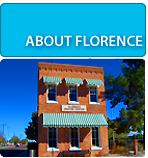




ABOUT FLORENCE, ARIZONA!
History of Florence Florence was established in 1866 by Colonel Levi Ruggles, who moved to Arizona after the Civil War as an Indian Agent. He later served as a Territorial Legislator and helped establish Pinal as the state’s fifth county. Agriculture was the major economic base until Florence became the government seat of Another milestone in Florence’s history was the canal boom in the 1880s which enabled water from the Gila River to be diverted for irrigation. Over time, farming and ranching again played a major role in Florence’s economy. The Florence Junior Parada began in 1932 when local ranchers held the rodeo to raise money for the Children’s Milk Fund. Today, the Florence Junior Parada is the oldest sanctioned youth rodeo in the world. The Arizona State Prison moved to Florence in 1908 replacing the Territorial Prison in Yuma. Inmates travelled from Yuma by train to build the prison and lived in the surrounding desert during its construction. The oldest buildings at the prison complex are the Administration Building built in 1928 and Cellblock Two (CB-2) which was completed in 1930. The gates leading into the Central Unit were brought to Florence from the Yuma Territorial Prison. Through its history, Florence’s architecture evolved from rustic Sonoran adobe brick buildings to the Modern Movement. Florence is noted for its collection of adobe buildings, the earliest dating back to 1868. All of the architectural styles slots that existed in Territorial Arizona can be found along the streets of Florence today. The most spectacular landmark in Florence is the 1891 Pinal County Courthouse. The 1891 Courthouse is an excellent example of American Victorian architecture which reflected the County Supervisors' commitment to continued growth and prosperity in Pinal County. Weather The weather in Florence is mild for much of the year. During the Winter months, expect daily high temperatures to range from 60 to 70 degrees with occasional periods of rain. Daily lows temperatures range from 30 to 40 degrees, occasionally dropping below freezing. Spring and Fall are usually warm and dry with highs in the 80s and 90s, lows in the 40s and 50s. Daily highs during the Summer months frequently exceed 100 degrees with the possibility of dust storms and thunderstorms. Always carry at least one gallon of water per person during the summer months.
|

 the newly formed Pinal County and silver was discovered at the Silver King Mine in 1875. Over the ensuing years, Florence played an important role as a regional administrative center. All federal land transactions for Southern Arizona were conducted in Florence until the Federal Land Office moved to Tucson in 1881. An early and prominent figure in Florence’s history was Charles D. Poston, known as the Father of Arizona. Poston encouraged Congress to create the Arizona Territory and was the territory’s first elected delegate to Congress.
the newly formed Pinal County and silver was discovered at the Silver King Mine in 1875. Over the ensuing years, Florence played an important role as a regional administrative center. All federal land transactions for Southern Arizona were conducted in Florence until the Federal Land Office moved to Tucson in 1881. An early and prominent figure in Florence’s history was Charles D. Poston, known as the Father of Arizona. Poston encouraged Congress to create the Arizona Territory and was the territory’s first elected delegate to Congress.